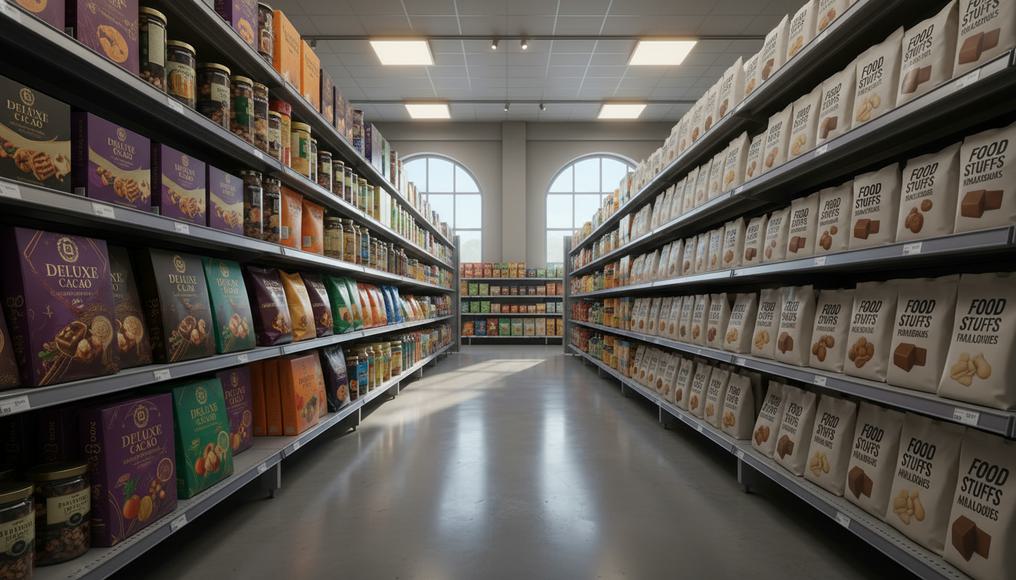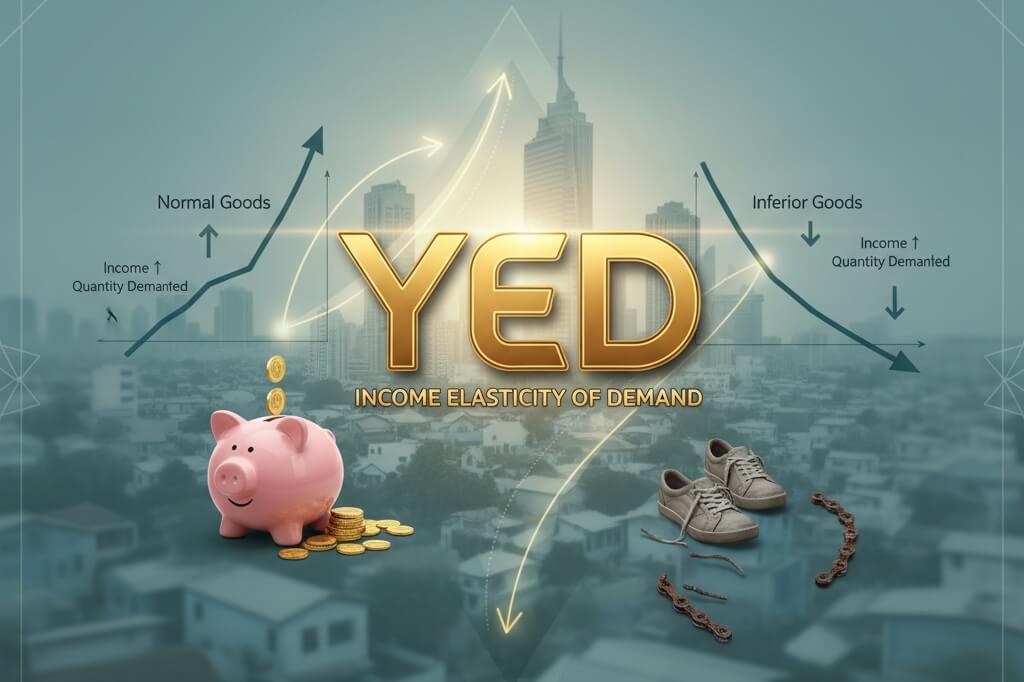
The Allure of That Extra Cash
Imagine landing a nice raise or a lucky windfall, and suddenly that gourmet coffee seems irresistible compared to your go-to budget option. Do you ramp up those indulgent purchases, or keep things the same? This is income elasticity of demand (YED) at play—economics’ clever tool for revealing how changes in your income influence what you buy and how much. For those just starting with A-Level economics, it’s not about dry charts; it’s about understanding those spontaneous shopping decisions that feel all too familiar. If you’re new to CAIE A-Level Economics, check out our Econ, But Friendly: 2025–26 CAIE A‑level Economics (9708) Starter Guide for a solid foundation. Let’s break it down, and by the end, you’ll be spotting YED everywhere, making you the go-to expert in your study group.
– Check out our Price elasticity of demand GUIDE.
– Check out our Cross elasticity of demand GUIDE.

Defining Income Elasticity of Demand (YED)
If economics lessons sometimes feel like a slog through endless numbers, income elasticity of demand (YED) brings the excitement. This key concept measures how the quantity demanded for a product or service shifts in response to changes in consumer income. It distinguishes between normal goods, where demand rises with income, and inferior goods, which see demand fall as people afford better alternatives.
To put it simply, while price elasticity focuses on how prices affect buying habits, YED highlights the impact of income fluctuations. For a deeper dive into price elasticity, explore our Understanding Price Elasticity of Demand: A Beginner’s Guide for A-Level Students. This is especially pertinent in the UK, where household incomes fell by 2.5% in 2023 but are rebounding, according to Office for National Statistics data. For beginners, grasping YED helps explain why luxury items surge in sales during economic upturns, such as the anticipated 1.2% UK growth in 2025, while affordable staples suffer in downturns.
Next time your pocket money increases, pay attention to your habits. Do you stock up on premium snacks (a normal good) or skip the generic brands (inferior goods)? That’s YED in your daily life, and it’s crucial exam material. Beyond theory, YED underpins Bank of England analyses on how income variations drive spending on electronics and vacations. As an A-Level foundation, it demystifies consumer behavior without requiring advanced expertise. To build on this, our CAIE AS Level Economics: The Price System and Microeconomy – Beginner’s Essential Guide covers elasticity in the broader microeconomic context.

Mastering the YED Formula and Calculations
Don’t worry if calculations sound daunting—we’ll keep it simple and relatable, like solving a puzzle from your favorite app. The core formula for income elasticity of demand is:
YED = (% change in quantity demanded) / (% change in income)
To find the percentage change in quantity demanded, use: (New Quantity – Old Quantity) / Old Quantity × 100. Apply the same for income changes. For minor variations, the arc method works well, and A-Level exams stick to these fundamentals.
Let’s try an example: Your weekly allowance rises from £20 to £25 (a 25% increase), and cinema visits go from 2 to 3 tickets (50% increase). YED = 50% / 25% = 2.0. This indicates elastic demand—movie outings are a luxury that responds strongly to more cash, spreading faster than your income boost. Practice similar calculations with our CAIE AS Economics – Topic Questions for hands-on reinforcement.
In the real UK context, after a 10% income rise post-2021, holiday bookings jumped 15%, yielding a YED of 1.5 (drawn from ONS figures). By 2024, as real incomes edged up 0.5% heading into 2025, electric vehicle sales soared 25%, with a YED of 2.1—clearly elastic.
On the flip side, a 10% income drop might reduce coffee consumption by just 5%, giving YED = 0.5, marking it as an inelastic essential. Test this with your own grocery receipts to build intuition; it transforms abstract math into practical insight. Fun fact: My personal YED for takeout food? Off the charts. These calculations reveal how income waves affect entire markets, like the gradual uptick in UK household disposable income boosting discretionary spending.

Understanding the Importance of YED’s Size, Sign, and Changes
The real intrigue in income elasticity of demand lies in the size, sign, and relative percentage changes of the YED value—think of it as interpreting signals from the spending world. The relative change is the ratio itself: A 5% income rise leading to an 8% demand increase for jewelry (YED > 1) signals luxury appeal. For essentials, a 2% demand rise means 0 < YED < 1—inelastic and reliable.
This matters for predicting economic patterns, much like forecasting weather based on trends. During the 2022 global recovery, luxury demand exceeded income growth by 20% in key sectors (insights from Corporate Finance Institute). In the UK, as incomes stabilize toward 2025, gadgets like smartphones remain highly elastic, influencing retailer strategies per Office for Budget Responsibility projections.
For starters, consider how a small salary hike might lead to subscribing to more entertainment services—that’s the relative shift exposing spending tendencies. In 2023’s slowdown, a 1% income decline cut UK restaurant visits by 1.5% (Institute for Fiscal Studies data).
The size and sign provide deeper clues: A high positive YED, like 3, means demand skyrockets—ideal for volatile luxuries such as high-end vacations (YED around 2.5 in 2024 Bank of England reports). Values between 0 and 1 indicate stable necessities. Negative YED points to inferior goods, where demand drops with rising income, like cheap convenience foods falling 5% on a 10% raise (YED -0.5, reflecting upgrade preferences).
Here’s a quick reference table:
| YED Value | Interpretation | Everyday Example |
|---|---|---|
| >1 (Positive) | Income Elastic (Luxury) | High-end fashion: More income, more buys! |
| 0 to 1 (Positive) | Income Inelastic (Necessity) | Groceries: Demand grows steadily. |
| <0 (Negative) | Inferior Good | Budget transport: Switch to better options when richer. |
These values evolve with societal shifts, such as sustainable products becoming more responsive. Once you get this, economic news will never look the same. For more on related microeconomic concepts, our CAIE AS Level Economics Study Notes provide detailed breakdowns.

Factors That Shape Income Elasticity of Demand
Income elasticity of demand isn’t fixed; it responds to various influences like a living, breathing entity. The primary driver is the good’s category: Luxuries boast high YED (>1), thriving on extra income—consider upscale clothing lines. Necessities hover low (0-1), unchanging much; food basics fit here. Inferior goods show negative YED, declining as alternatives emerge, with UK discount brands seeing 3% sales drops amid 2024 wage increases.
Availability of substitutes plays a huge role too. Abundant choices, like streaming platforms, heighten YED—easy to upgrade. Unique items, such as prescription drugs, remain inelastic. Demographics add nuance: Younger UK consumers display YED around 1.8 for gadgets, while older groups favor essentials. This ties into broader scarcity and choice discussions—see our guide on Understanding Scarcity, Choices, and Opportunity Cost in A-Level Economics for foundational insights.
Time horizon matters—short-term habits keep YED low, but long-term changes, like the post-2023 surge in cycling over driving, allow adaptation. Broader economic conditions, including 2024’s UK inflation, make luxuries more sensitive. Brand loyalty can dampen elasticity, as devoted customers stick around.
In the EU, organic foods reached YED 1.8 with 7% income growth from 2015-2022, fueled by health trends and options (Corporate Finance Institute). For A-Level learners, these elements show YED’s dynamic nature, intertwined with culture and finances. Lighthearted note: My YED for online shopping? Always high.

Real-Life Applications: Examples and Case Studies in YED
Bringing income elasticity of demand to life through examples makes it stick. In the UK after Brexit, stabilizing incomes from 2023-2024 propelled electric car demand to a YED of 2.1 (25% sales rise on 12% income growth, ONS data). It’s a green luxury gaining traction despite currency fluctuations that hurt low-wage service sectors, dropping budget travel YED to -0.5.
The pandemic era highlighted shifts: 2020-2021 income falls boosted inferior goods like home-cooked meals (YED -1.2 in UK and US), but recovery unleashed pent-up demand, contributing to 3% GDP growth in early 2021 (European Central Bank). Streaming services excelled, with Netflix adding 20 million subscribers amid 2022 wage gains, showing YED >1 in affluent areas versus inelastic utilities.
In London’s 2023 landscape, wage pressures rendered cheap getaways inferior (YED -0.5). Post-pandemic fuel use exhibited YED >1, outpacing income recovery. On inequality, lower-income groups showed higher elasticity for basics during 2024 disruptions.
Think of YED like curating your playlist: More income means premium tracks; less means basics. These stories connect theory to the everyday. For advanced applications, dive into our CAIE A2 Economics Study Notes.

Strategic Insights: How Businesses Use YED for Decisions
The implications of income elasticity of demand for business decision-making are profound—it’s like having a roadmap for revenue. For high-YED luxuries, companies ramp up advertising during expansions; premium supermarket ranges flourish then. In recessions, low-YED essentials rely on high-volume strategies, as seen with value lines surging 15% in the 2008 downturn.
Pricing strategies adapt accordingly: Negative YED prompts shifting from budget to upscale offerings, boosting sales like a 12% lift in luxury retail in 2023. Forecasting relies on YED to anticipate trends—taxing elastic luxuries minimally impacts essentials. In UK 2024, high-YED sustainable apparel doubled with 10% income rises.
Investment decisions balance elastic high-end products with inelastic staples. Policymakers, via Office for Budget Responsibility 2025 forecasts, apply YED=1.0 to exports for post-Brexit planning. As one expert notes, “YED transforms economic indicators into actionable strategies” (McCracken Alliance). For small ventures like coffee shops, a YED of 1.2 for specialty drinks calls for promotions during income peaks. This links individual choices to broader growth, aligning with the UK’s projected 1.2% expansion in 2025 (S&P Global). Key advice: Regularly assess YED to stay agile. If you’re studying Edexcel, our Edexcel A‑Level Economics 2025–2026: Essential Student Guide offers similar strategic insights.
![]()
Practical Tips to Apply YED Knowledge
To make income elasticity of demand work for you:
- Track your spending: Use ONS data or a spreadsheet to calculate personal YED and spot patterns.
- Categorize purchases: Identify luxuries, necessities, or inferior goods to forecast behaviors.
- For business ideas: Target high-YED areas like eco-friendly tech for growth potential.
- In discussions: Analyze tax policies on elastic items for relevant debates.
- Study smarter: Use examples to quiz peers, turning prep into interactive fun. Try our CAIE A2 Economics – Topic Questions for targeted practice.

Frequently Asked Questions About YED
How does YED differ from price elasticity?
YED examines income effects, while price elasticity tracks price impacts—both measure responsiveness but target different factors.
Can YED be exactly 1?
Yes, unit elastic means demand changes match income—common for items like casual apparel.
Why do inferior goods have negative YED?
As income grows, consumers opt for superior substitutes, reducing demand for cheaper options.
Does YED apply to services?
Absolutely—think inelastic budget rides versus elastic luxury travel.
Is YED constant over time?
No, it evolves with market changes; coffee might be inelastic in tough times but elastic in prosperous ones.
How to handle incomplete income data?
Use proxies like GDP per capita or household surveys for accuracy.
Does inflation affect YED calculations?
Yes—always use real income, adjusted for inflation, for precise results.
Wrapping Up YED’s Impact
When your next raise arrives, recognize YED behind those tempting buys—it’ll not only explain your choices but sharpen your A-Level performance.
**Related Articles**:
– Price elasticity of demand GUIDE.
– Cross elasticity of demand GUIDE.
References
- Corporate Finance Institute: https://corporatefinanceinstitute.com/resources/economics/income-elasticity-of-demand/
- Office for National Statistics: https://www.ons.gov.uk/economy/nationalaccounts/uksectoraccounts/articles/quarterlyeconomiccommentary/apriltojune2025
- Bank of England: https://www.bankofengland.co.uk/monetary-policy-report/2025/february-2025
- Office for Budget Responsibility: https://obr.uk/efo/economic-and-fiscal-outlook-march-2025/
- S&P Global Ratings: https://www.spglobal.com/ratings/en/research/articles/250130-uk-economic-outlook-q4-2024-inflation-and-labor-costs-are-a-persistent-challenge-13210642
- Institute for Fiscal Studies: https://ifs.org.uk/publications/uk-economic-outlook-navigating-endgame
- European Central Bank: https://www.ecb.europa.eu/pub/economic-bulletin/html/eb202304.en.html
